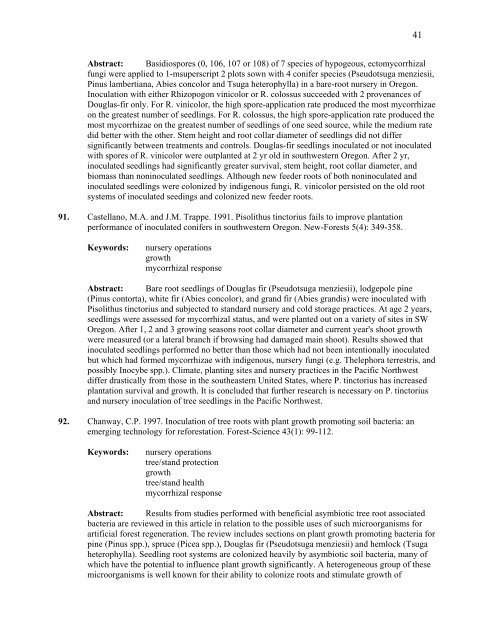IntensIve sIlvIculture - Forest Science Labs - Research Network ...
IntensIve sIlvIculture - Forest Science Labs - Research Network ...
IntensIve sIlvIculture - Forest Science Labs - Research Network ...
You also want an ePaper? Increase the reach of your titles
YUMPU automatically turns print PDFs into web optimized ePapers that Google loves.
Abstract: Basidiospores (0, 106, 107 or 108) of 7 species of hypogeous, ectomycorrhizal<br />
fungi were applied to 1-msuperscript 2 plots sown with 4 conifer species (Pseudotsuga menziesii,<br />
Pinus lambertiana, Abies concolor and Tsuga heterophylla) in a bare-root nursery in Oregon.<br />
Inoculation with either Rhizopogon vinicolor or R. colossus succeeded with 2 provenances of<br />
Douglas-fir only. For R. vinicolor, the high spore-application rate produced the most mycorrhizae<br />
on the greatest number of seedlings. For R. colossus, the high spore-application rate produced the<br />
most mycorrhizae on the greatest number of seedlings of one seed source, while the medium rate<br />
did better with the other. Stem height and root collar diameter of seedlings did not differ<br />
significantly between treatments and controls. Douglas-fir seedlings inoculated or not inoculated<br />
with spores of R. vinicolor were outplanted at 2 yr old in southwestern Oregon. After 2 yr,<br />
inoculated seedlings had significantly greater survival, stem height, root collar diameter, and<br />
biomass than noninoculated seedlings. Although new feeder roots of both noninoculated and<br />
inoculated seedlings were colonized by indigenous fungi, R. vinicolor persisted on the old root<br />
systems of inoculated seedings and colonized new feeder roots.<br />
91. Castellano, M.A. and J.M. Trappe. 1991. Pisolithus tinctorius fails to improve plantation<br />
performance of inoculated conifers in southwestern Oregon. New-<strong>Forest</strong>s 5(4): 349-358.<br />
Keywords: nursery operations<br />
growth<br />
mycorrhizal response<br />
Abstract: Bare root seedlings of Douglas fir (Pseudotsuga menziesii), lodgepole pine<br />
(Pinus contorta), white fir (Abies concolor), and grand fir (Abies grandis) were inoculated with<br />
Pisolithus tinctorius and subjected to standard nursery and cold storage practices. At age 2 years,<br />
seedlings were assessed for mycorrhizal status, and were planted out on a variety of sites in SW<br />
Oregon. After 1, 2 and 3 growing seasons root collar diameter and current year's shoot growth<br />
were measured (or a lateral branch if browsing had damaged main shoot). Results showed that<br />
inoculated seedlings performed no better than those which had not been intentionally inoculated<br />
but which had formed mycorrhizae with indigenous, nursery fungi (e.g. Thelephora terrestris, and<br />
possibly Inocybe spp.). Climate, planting sites and nursery practices in the Pacific Northwest<br />
differ drastically from those in the southeastern United States, where P. tinctorius has increased<br />
plantation survival and growth. It is concluded that further research is necessary on P. tinctorius<br />
and nursery inoculation of tree seedlings in the Pacific Northwest.<br />
92. Chanway, C.P. 1997. Inoculation of tree roots with plant growth promoting soil bacteria: an<br />
emerging technology for reforestation. <strong>Forest</strong>-<strong>Science</strong> 43(1): 99-112.<br />
Keywords: nursery operations<br />
tree/stand protection<br />
growth<br />
tree/stand health<br />
mycorrhizal response<br />
Abstract: Results from studies performed with beneficial asymbiotic tree root associated<br />
bacteria are reviewed in this article in relation to the possible uses of such microorganisms for<br />
artificial forest regeneration. The review includes sections on plant growth promoting bacteria for<br />
pine (Pinus spp.), spruce (Picea spp.), Douglas fir (Pseudotsuga menziesii) and hemlock (Tsuga<br />
heterophylla). Seedling root systems are colonized heavily by asymbiotic soil bacteria, many of<br />
which have the potential to influence plant growth significantly. A heterogeneous group of these<br />
microorganisms is well known for their ability to colonize roots and stimulate growth of<br />
41
















